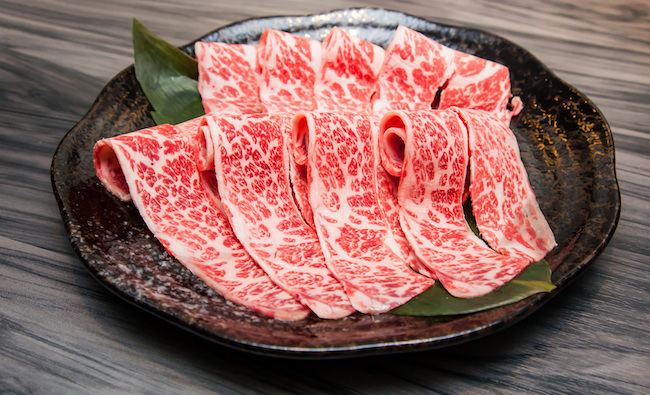 | ||
Similar Matsusaka beef, Marbled meat, Beef, Rib eye steak, Teppanyaki | ||
Kobe beef teppanyaki food in japan
Kobe beef (神戸ビーフ, Kōbe bīfu) (KO-BEH) refers to beef from the Tajima strain of Wagyu cattle, raised in Japan's Hyogo Prefecture according to rules as set out by the Kobe Beef Marketing and Distribution Promotion Association. The meat is a delicacy renowned for its flavor, tenderness, and fatty, well-marbled texture. Kobe beef can be prepared as steak, sukiyaki, shabu shabu, sashimi, and teppanyaki. Kobe beef is generally considered one of the three top brands (known as Sandai Wagyuu, "the three big beefs"), along with Matsusaka beef and Ōmi beef or Yonezawa beef.
Contents
- Kobe beef teppanyaki food in japan
- 200 kobe beef steak vs 20 kobe beef steak
- History
- Industry
- Kobe beef in other countries
- Kobe style beef
- Mislabelling
- References
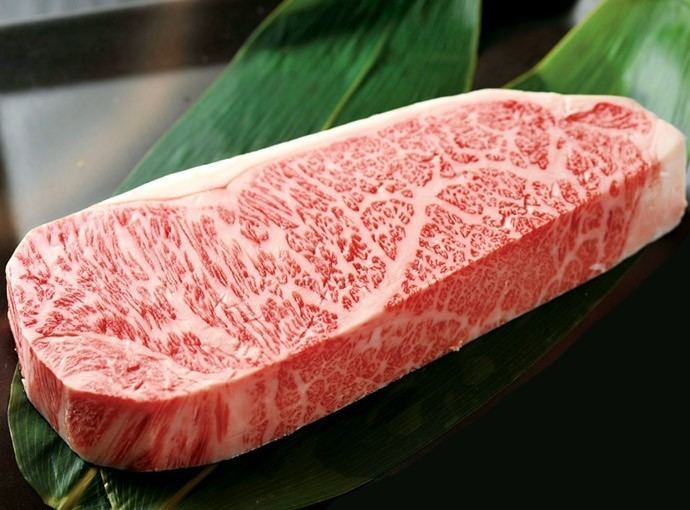
Kobe beef is also called Kobe niku (神戸肉, "Kobe meat"), Kobe-gyu (神戸牛) or Kobe-ushi (神戸牛, "Kobe cattle") in Japanese.
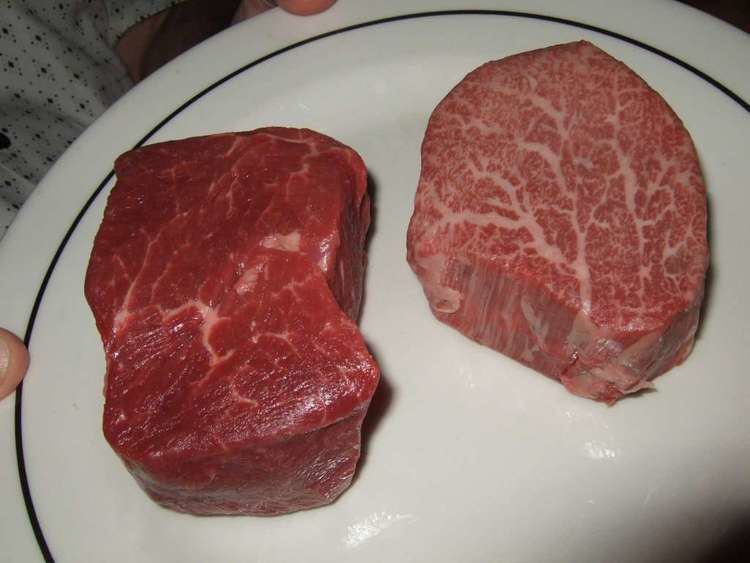
200 kobe beef steak vs 20 kobe beef steak
History
Cattle were introduced in Japan in the second century as work animals used for rice cultivation. Because of Japan's "difficult terrain and sparse arable land" due in part to its mountainous topography, cattle were bred in small, isolated regions, yielding herds with unique qualities in their meat.
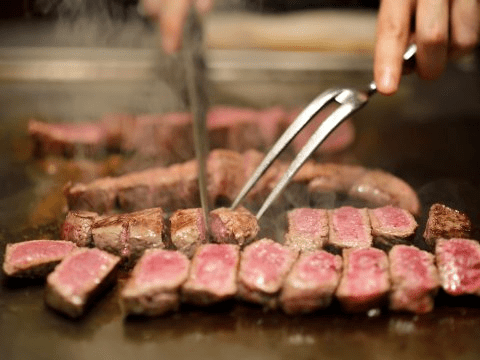
After the Meiji Restoration, beef consumption remained low, but it has steadily increased since the end of World War II. Kobe beef grew in popularity and extended its global reach in the 1980s and 1990s.
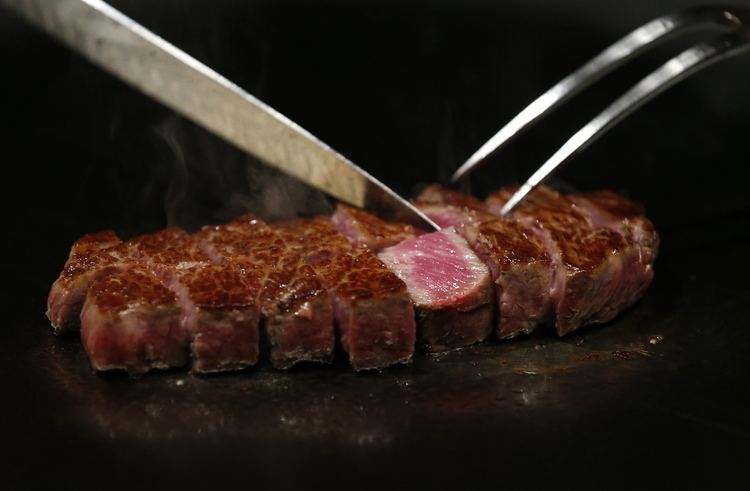
In the late 19th century, native Japanese cattle were interbred with European breeds, including Brown Swiss, Shorthorn, and Devon. The cattle originally recognized in 1943 as "Kobe beef" were cattle from herds in the Kobe area of Japan, and could be any of four breeds of Wagyu cattle—Akaushi (Japanese Red/Brown), Kuroushi (Japanese Black), Japanese Polled, and Japanese Shorthorn. Tajima is a strain of the Japanese Black, the most populous breed (around 90% of the four breeds).
In 1983, the Kobe Beef Marketing and Distribution Promotion Association was formed to define and promote the Kobe trademark. It sets standards for animals to be labeled as Kobe beef.
In 2009, the USDA placed a ban on the import of all Japanese beef to prevent the Japan foot-and-mouth outbreak from reaching US shores. The ban was relaxed in August, 2012. Shortly thereafter, Kobe beef was imported into the US for the first time.
Industry
Kobe beef in Japan is a registered trademark of the Kobe Beef Marketing and Distribution Promotion Association (神戸肉流通推進協議会, Kōbeniku Ryūtsū Suishin Kyōgikai). It must fulfill all the following conditions:
The cattle are fed on grain fodder and brushed sometimes for setting fur. The melting point of fat of Kobe beef (Tajima cattle) is lower than common beef fat.
Wagyu beef is much higher in unsaturated fat. It has high levels of oleic acid, the fatty acid in olive and canola oil that has been shown to lower bad LDL cholesterol. Tajima cattle are fattened longer, living about 26 to 32 months, compared to 18 months for US beef cattle.
Part of the high price is because only about 3,000 head of cattle may qualify as Kobe. In Japan, all cattle, not just those that end up as Kobe beef, can be tracked via a 10-digit number through every step of its entire lifecycle.
Kobe beef in other countries
Prior to 2012, Kobe beef was not exported. The first exports, in January 2012, were to Macau, then to Hong Kong in July 2012. Since then, exports have also been made to the United States, Singapore, Thailand and one chef in Canada.
"Kobe-style" beef
The increase in popularity of Japanese beef in the United States has led to the creation of "Kobe-style" beef, taken from domestically raised Wagyu crossbred with Angus cattle, to meet the demand. Farms in the United States and Britain have attempted to replicate the Kobe traditions. From the first Wagyu cattle imported in the 1970s, 150 US ranches now raise "tens of thousands of Wagyu cattle".
The meat produced by these cross-breeds is different from the "authentic" Kobe beef, though this is "often by design", due to the perception that American palates do not actually want the richness of Japanese beef and would prefer a more familiar flavor profile. Some US meat producers claim any differences between their less expensive "Kobe-style" beef and true Kobe beef are largely cosmetic. Cuts of US "Kobe-style" beef tend to have darker meat and a bolder flavor.
In Europe, UK grocery retailer Asda, owned by Wal-Mart, introduced Wagyu beef at the end of 2011 under its Butcher’s Selection line using meat from a herd in Yorkshire, "bred from Holstein dairy cows impregnated with Wagyu semen". This not only made the beef more affordable, but it also resulted in less marbled meat more familiar to UK consumers. In June 2014, the German discounter Aldi announced that it was going to introduce Wagyu beef steaks, "with every store receiving a limited number of 50 steaks, priced at a very competitive £6.99 for an 8-oz (225-g) sirloin and rib eye". However, Aldi’s Wagyu beef was sourced from New Zealand, where the exclusively grass-fed cattle are allowed to roam, more in keeping with changing norms around animal welfare (in Japan cattle are "confined in small pens and given much more energy-dense feed").
Mislabelling
The proliferation of beef outside Japan marketed as Kobe beef is an issue for Kobe beef farmers. Due to a lack of legal recognition of the Kobe beef trademark in the United States, it is possible to sell meat that is incorrectly labeled as Kobe beef. The Kobe Beef Marketing and Distribution Promotion Association planned to publish pamphlets about Kobe beef in foreign languages.
Japan has a Wagyu Beef Export Promotion Committee.
